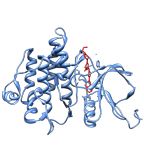Dasatinib Achieves Higher Response Rate Than Imatinib in CML
A study comparing dasatinib to imatinib in patients with chronic myeloid leukemia found that the second-generation TKI dasatinib yielded better remission and molecular response rates than imatinib, but these did not result in better survival outcomes.
A study comparing the second generation tyrosine kinase inhibitor (TKI) dasatinib to imatinib for patients with chronic myeloid leukemia (CML) found that dasatinib yielded better 12-month molecular response rates and complete cytogenetic remission rates than imatinib, but these results did not translate into better survival outcomes. Rates of progression-free and overall survival were similar in both arms of the trial.

Structure of ABL1 kinase domain in complex with dasatinib; source: SocratesJedi, Wikimedia Commons
“The treatment of chronic myeloid leukemia has been revolutionized by the tyrosine kinase inhibitor imatinib mesylate, which inhibits the constitutively active fusion gene BCR-ABL, found in virtually all cases of CML,” wrote authors led by Jerald P. Radich, MD, of the Fred Hutchinson Cancer Research Center in Seattle, published online before print in the journal Blood. Trials have shown, however, that a substantial proportion of CML patients are resistant or intolerant of imatinib, and there have been indications that another TKI, dasatinib could fill that gap.
In the new trial, Radich and colleagues randomized 253 patients with newly diagnosed chronic phase CML to either imatinib 400 mg once daily or dasatinib 100 mg once daily; 246 patients were included in the final analysis. Only 11 patients had died at this point in the analysis, yielding similar overall survival rates between the imatinib and dasatinib groups of 97% for both. progression-free survival was also similar; at three years, the progression-free survival rate in the imatinib group was 90%, compared with 93% in the dasatinib arm.
Response rates were better in the dasatinib-treated patients, however. A total of 84% of dasatinib patients achieved a complete cytogenetic remission vs 69% of imatinib patients. At one year, 59% of dasatinib patients achieved a molecular response defined as a 3-log reduction in BCR-ABL transcript levels; 44% of imatinib patients achieved this level of molecular response (P = .059). The median BCR-ABL mRNA reduction after 1 year of treatment was 3.3 log for the dasatinib group and 2.8 log for the imatinib patients (P = .063).
Complete hematologic response, however, was again similar, with 82% achieving a complete hematologic response in the imatinib group and 81% in the dasatinib group (P = 1.00).
Toxicity appeared to be worse with dasatinib, with 15% of patients experiencing grade 4 toxicities compared to only 2% of imatinib patients (P = .0001).
The authors wrote that these data along with other recent trials have now painted a consistent picture: second generation TKIs such as dasatinib and nilotinib have superior short-term response rates, but with no corresponding improvement in survival. This may be due to a lack of sufficient follow-up, trials with enough patients, or simply a characteristic of the disease being treated.
“Thus for newly diagnosed chronic phase CML, we now have an embarrassment of riches-a ‘standard’ frontline therapy (imatinib) with a long-term track record with regard to response and toxicity; and two more potent second generation drugs (dasatinib and nilotinib), with an improved short-term response that may translate into long-term benefits,” the authors wrote. Choosing which drug to use can therefore be difficult for clinicians, but factors including physician experience and comfort, compliance issues (once a day with dasatinib and imatinib vs twice a day for nilotinib), obvious comorbidities that might suggest one agent over another, and that patients at higher risk of progression might benefit from dasatinib or nilotinib.